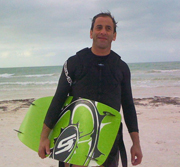
Diasonics Medical Systems, South San Francisco, California
MRI Scientist, 1985-1986
Principle Investigator - Dr. Leon Kaufmann, MD, Ph.D.
Conducted research of advanced procedures for MRI utilizing the Diasonics .5 Tesla MTS imaging system. Developed techniques for Oblique Plane imaging. Technique utilized novel approaches to overcome the problems of low signal-to-noise ratio associated with non-optimum gradient tuning of oblique imaging. Developed technique of Ultra-High-Resolution nominal plane imaging. Implementation necessitated off-center detection techniques to avoid aliasing due to small field of view.
Advanced technique of Short-Echo High-Contrast imaging. Technique is used to highlight tissue with short T2 relaxation times without the necessity of post data acquisition signal processing. Developed technique for High Signal-to-Noise Ratio imaging of the Lumbar Spine. Technique utilized reorientation of the Readout and Phase Encoding Gradients to avoid degradation due to breathing artifact.
General Electric Medical Systems - MRI Division, Fremont, California
MRI Scientist, 1984
Principle Investigator - Dr. James Oppenheimer Ph.D.
Conducted research of MRI techniques on a 2.3 Tesla small bore animal imaging and spectroscopy system.
Developed an extensive software package in "C" for the automated control of MRI hardware. Implemented all standard pulse sequences including single-slice, high and low resolution, 3-dimensional multi-slice, and imaging-spectroscopy. Implemented methods to maximize user flexibility. Conducted experiments to determine penetration and signal-to-noise characteristics of surface coils.
Lawrence Berkeley Laboratory Berkeley, California
Research Medicine Division
Graduate Researcher, 1984-1985
Principle Investigator - Dr. Thomas Budinger MD, Ph.D.
Proposed and conducted research for a new high-speed MRI pulse sequence. Sequence was a hybrid between the widely used 2-dimensional Spin-Warp technique and the single excitation Echo-Planer technique. Pulse sequence was named Phase-Encoded Rapid Multiple Echo (PERME) Imaging. PERME utilized multiple spin echoes to encode multiple phase encodes in a single excitation. The total imaging time was decreased and patient throughput was increased.
To conduct the investigation a software simulation package was developed in FORTRAN which simulates the MRI process. Analytic phantoms were used and the MRI signal was calculated using the K-space formulation of MRI data acquisition.
MRI Publications, Conferences and Seminars
Published Phase-Encoded Rapid Multiple Echo (PERME) Nuclear Magnetic Resonance Imaging, Lawrence Berkeley Laboratory Press, Prepared for the US Department of Energy, 1985
Society of Magnetic Resonance in Medicine: Presented poster entitled: Phase-Encoded Rapid Multiple Echo Nuclear Magnetic Resonance Imaging to the MRI community, London, 1985
Attended Society of Magnetic Resonance in Medicine seminar in New York
Presented seminar to UC, Berkeley & UCSF joint Bioengineering Program entitled: Utilization of the K-space formulation of MRI imaging in the design and analysis of pulse sequences, April 1985
Presented seminar to General Electric Medical Systems entitled: The K-space formulation of MRI and it's implications for high-speed imaging., March 1985
Presented seminar to the Lawrence Berkeley Labs, Research Medicine Division entitled: Results and Implications of PERME imaging. Results indicated that the point spread function associated with PERME imaging was a viable alternative, February 1985